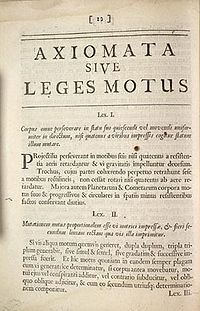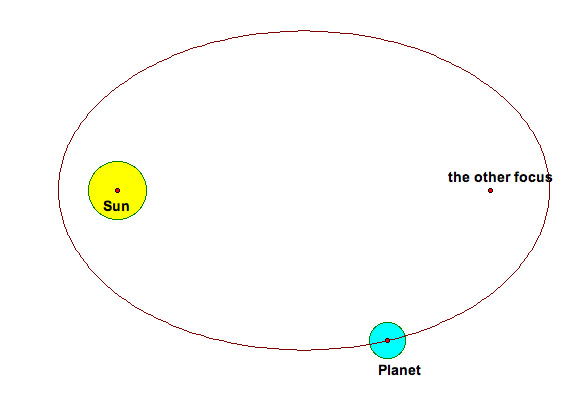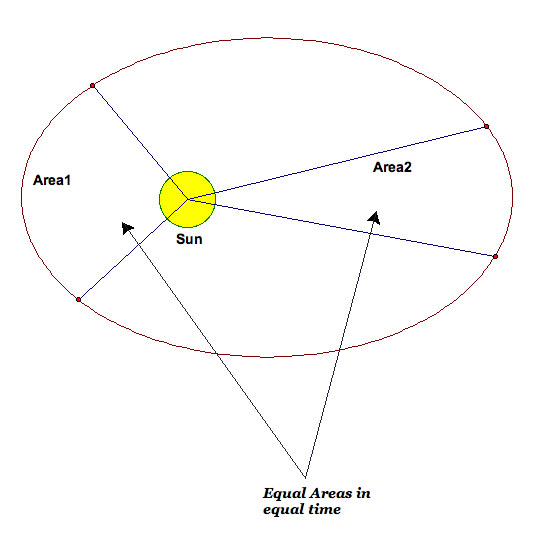

Written by Sunny Yoon
According to dictionary.com, the definition of an orbit is a curved path, usually elliptical, described by a planet, satellite, spaceship, etc., around a celestial body, as the sun. Planets orbit around the sun, while many moons in the solar system orbit their respective planets. Scientists have created many man-made orbits such as satellites are placed around the Earth. These orbits follow the same mathematical laws of motion.
An Introduction to Newton's Three Laws of Motion
 Sir Isaac Newton (1642-1727) first compiled these laws in his work Philosphiae Naturalis Principa Mathematica, first published on July 5, 1687. Newton used the laws to explain and investigate the motion of many physical objects and systems.
Sir Isaac Newton (1642-1727) first compiled these laws in his work Philosphiae Naturalis Principa Mathematica, first published on July 5, 1687. Newton used the laws to explain and investigate the motion of many physical objects and systems.
Newton's First Law of Motion:
| Every object in a state of uniform motion tends to remain in that state of motion unless an external force is applied to it. |
This we recognize as essentially Galileo's concept of inertia, and this is often termed simply the "Law of Inertia."
Galileo first discovered the law and Newton gave credit to him in his work. Before Galileo, the viewpoint of Aristotle was more commonly believed. According to the physics of Aristotle, one must exert force in order to cause and preserve motion. He used this basis to explain his logic of motion of objects. He believed that all matter is composed of five elements: fire, earth, air, water, and Aether (divine substance of the heavens). These worldly elements had natural realms except Aether. For example, we exist where the Earth realm meets the Air realm so the ground is beneath our feet and the air all around us is up and high as far as we can see. The natural state of objects was at rest, in a location that was in balance with the elements of which they were composed. Therefore, the motion of objects was an attempt by an object to reach its natural state. An apple falls because the Earth realm is down. Water flows downward because its natural realm is beneath the Earth realm.
Newton’s first law can be described in two different situations:
The first statement is obvious for us to understand, but it’s the second statement where students may experience confusion unless they are familiar with concept of friction. For example, a ball will not roll across the room forever; it slows down and eventually comes to a stop. According to Newton’s first law, the ball comes to a stop because of a net external force applied in the direction opposite of its motion. This external force is due to a frictional force between the ball and the ground, as well as a frictional force between the ball and the air. If the room were frictionless and the ball were traveling in a vacuum, the net external force on the ball would be zero, therefore, it would travel with constant velocity as long as its path were unobstructed.
Newton's Second Law of Motion:
The relationship between an object's mass m, its acceleration a, and the applied force F is F = ma. Acceleration and force are vectors; in this law the direction of the force vector is the same as the direction of the acceleration vector.
This second law allows quantitative calculations of dynamics: how do velocities change when forces are applied. This law distinguishes the difference between Newton and Aristotle. Under Aristotle’s physics, there is only a velocity if there is a force, whereas Newton acknowledges that an object with a certain velocity maintains that velocity unless a force acts on it to cause an acceleration (i.e. a change in the velocity).
Newton's Third Law of Motion:
For every action there is an equal and opposite reaction. |
This law means that all forces are interactions; therefore, there is no such thing as a unidirectional force. If body A exerts a force on body B, body B simultaneously exerts a force of the same magnitude on body A – both forces acting along the same line.
As shown in the picture above, the skaters' forces on each other are equal in magnitude, but act in opposite directions. Although the forces are equal, the lacerations are not: the less massive skater will have a greater acceleration due to Newton's second law.
Let's try to think about this certain situation:
"Throw a ball in a horizontal direction toward the sky. Gravity pulls it in a trajectory back to Earth, and the greater the horizontal velocity, the farther it will travel before hitting the ground. Because of the curvature of Earth, however, different results are possible. When the ball's horizontal velocity is slow, the curvature of the ball's path is greater than the curvature of Earth, and the ball falls back to the ground . When the ball's forward motion is fast enough, it is pulled into a path whose curvature matches the curvature of Earth, and the ball enters into a circular orbit. In this situation, the ball is continuously falling toward Earth, but because the curvatures match, the ball never hits the ground. If the ball is thrown with greater initial horizontal velocity, Earth's curvature will be greater than the trajectory of the ball and the resulting orbit will be elliptical. In the latter two situations, the orbiting ball is in a state of continuously falling toward the center of Earth. If gravity were suddenly to disappear, the ball would fly away in a straight line just as an object tied to the end of a string and twirled overhead does if the string is suddenly released" (Mission Mathematics II: Grade 9 - 12, pp. 63-64).
From this situation, there is a new definition that we need to understand, gravity.
What is gravity?
It's a force of attraction that exists between any two objects that have mass. The more mass they have, the greater the force of attraction. The closer they are, the greater the force of attraction. |
Newton discovered that the gravitational attraction between two bodies is directly proportional to the product of their masses and inversely proportional to the square of the distance between their centers.

where G is the universal gradational constant  ,
,
m1 is the mass of one of the objects,
m2 is the mass of the other object,
r is the radius of separation between the center of masses of each object,
FG is the force of attraction between the two objects.
An Introduction to Kepler's Three Laws of Planetary Motion
Kepler's First Law:
| The orbits of the planets are ellipses, with the Sun at one focus of the ellipse. |

Kepler's First Law is illustrated in the image shown above. The Sun is not at the center of the ellipse, but is instead at one focus (generally there is nothing at the other focus of the ellipse). The planet then follows the ellipse in its orbit, which means that the Earth-Sun distance is constantly changing as the planet goes around its orbit.
Kepler's Second Law:
The line joining the planet to the Sun sweeps out equal areas in equal times as the planet travels around the ellipse. |

The line joining the Sun and planet sweeps out equal areas in equal times, so the planet moves faster when it is nearer the Sun. Thus, a planet executes elliptical motion with constantly changing angular speed as it moves about its orbit.
Kepler's Third Law:
| The ratio of the squares of the revolutionary periods for two planets is equal to the ratio of the cubes of their semi major axes. |
Kepler's Third Law implies that the period for a planet to orbit the Sun increases rapidly with the radius of its orbit. Thus, we find that Mercury, the innermost planet, takes only 88 days to orbit the Sun but the outermost planet (Pluto) requires 248 years to do the same.
Investigation 1 - Plot the orbit of the Earth
Investigation 2 - Plot the orbit of Mercury
References
Isaac Newton - http://en.wikipedia.org/wiki/Isaac_Newton
Newton's law of motion -http://en.wikipedia.org/wiki/Newton%27s_laws_of_motion
Newton's three laws of motion - http://csep10.phys.utk.edu/astr161/lect/history/newton3laws.html
The law of inertia - http://muse.tau.ac.il/museum/galileo/the_law_of_inertia.html
Natural philosophy of Aristotle -http://physics.about.com/od/physicshistory/a/GreekPhysics_2.htm
Gravitational Attraction - http://regentsprep.org/regents/physics/phys01/unigrav/default.htm
Kepler's three laws - http://csep10.phys.utk.edu/astr161/lect/history/kepler.html
House, P. A., & Day, R. P. (2005). Unit 3: Orbits. In P. House & R. Day (Eds.), Mission Mathematics II: Grace 9 - 12 (63-65).
Reston, VA: National Council of Teachers of Mathematics.